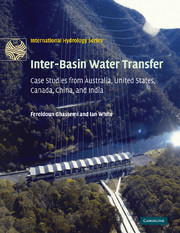Book contents
- Frontmatter
- Contents
- Foreword
- Overview and Scope
- Acknowledgements
- List of Abbreviations
- Part I The Challenges
- Part II Inter-basin Water Transfer in Australia
- Part III Inter-basin Water Transfer in Other Selected Countries
- Part IV Appendices
- Appendix A Some of the Australian pioneers of inter-basin water transfer
- Appendix B Construction timetable of the Snowy Mountains Hydro-electric Scheme
- Appendix C Details of diversion schemes from the Clarence River Basin
- Appendix D Chronological table of the most important events in the Goldfields Pipeline Scheme, Western Australia
- Appendix E Flooding of the Sahara depressions
- Appendix F The Ord River Irrigation Scheme
- Appendix G The West Kimberley Irrigation Scheme
- Appendix H Some other water transfer schemes in Australia
- Appendix I Selected technical features of the Central Valley Project in California
- Appendix J Selected technical features of the State Water Project in California
- Appendix K Selected characteristics of some of the completed or proposed inter-basin water transfer projects in Australia, United States, Canada, China and India, in chronological order
- Glossary
- Index
- References
Appendix F - The Ord River Irrigation Scheme
Published online by Cambridge University Press: 05 November 2009
- Frontmatter
- Contents
- Foreword
- Overview and Scope
- Acknowledgements
- List of Abbreviations
- Part I The Challenges
- Part II Inter-basin Water Transfer in Australia
- Part III Inter-basin Water Transfer in Other Selected Countries
- Part IV Appendices
- Appendix A Some of the Australian pioneers of inter-basin water transfer
- Appendix B Construction timetable of the Snowy Mountains Hydro-electric Scheme
- Appendix C Details of diversion schemes from the Clarence River Basin
- Appendix D Chronological table of the most important events in the Goldfields Pipeline Scheme, Western Australia
- Appendix E Flooding of the Sahara depressions
- Appendix F The Ord River Irrigation Scheme
- Appendix G The West Kimberley Irrigation Scheme
- Appendix H Some other water transfer schemes in Australia
- Appendix I Selected technical features of the Central Valley Project in California
- Appendix J Selected technical features of the State Water Project in California
- Appendix K Selected characteristics of some of the completed or proposed inter-basin water transfer projects in Australia, United States, Canada, China and India, in chronological order
- Glossary
- Index
- References
Summary
INTRODUCTION
The Ord River Irrigation Scheme is located in the northern part of Western Australia and the Northern Territory (Figure F.1). The region experiences the tropical climate of the Kimberley region with a wet and a dry season. Average annual rainfall at Kununurra is 793 mm. Its mean daily maximum temperature ranges from 30.7°C in July to 38.9°C in November, while the mean daily minimum temperature varies from 15.4°C in July to 25.6°C in December (Australian Bureau of Meteorology website).
Interest in the Kimberley region of Western Australia, including the Ord River Valley, began with Alexander Forrest's report of his exploration of the Fitzroy and Ord River Valleys between 1875 and 1879. The potential of the Ord River Valley for irrigated agriculture was first recognised in the late 1930s (Department of National Resources, 1976; Young, 1979). In 1941 a party of engineers and scientists explored the area and established that the Ord River could be dammed at one of many sites and provide water to a large fertile plain. In the same year, a small experimental farm was established on the banks of the Ord River near the off-take of the present M1 Supply Channel (Figure F.1). In the next four years, the Western Australian Government sponsored more detailed investigations. These concluded that 22 000 ha of land could be irrigated, and a further 50 000 ha extending into the Northern Territory, warranted further examination.
- Type
- Chapter
- Information
- Inter-Basin Water TransferCase Studies from Australia, United States, Canada, China and India, pp. 384 - 392Publisher: Cambridge University PressPrint publication year: 2007



